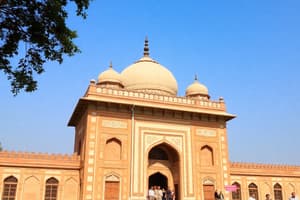Podcast
Questions and Answers
মুঘল সাম্রাজ্যের প্রধান উদ্দেশ্য ছিল
মুঘল সাম্রাজ্যের প্রধান উদ্দেশ্য ছিল
- বৌদ্ধ ধর্মের প্রচার ও প্রচার
- মানুষের অধিকার ও ন্যায়
- প্রভুতা এবং সাংস্কৃতিক উন্নতি (correct)
- রাজনীতি এবং চালাচলের স্থিতিশীলতা
নিম্নরূপের মধ্যে, মুঘল সাম্রাজ্যের একটি গুরুত্বপূর্ণ প্রতিষ্ঠাতা ছিল
নিম্নরূপের মধ্যে, মুঘল সাম্রাজ্যের একটি গুরুত্বপূর্ণ প্রতিষ্ঠাতা ছিল
- বাবুর (correct)
- জাহাংগীর
- শাহ জাহান
- আকবর
মোরিয়া সাম্রাজ্যের স্থাপনা করা হয়েছিল
মোরিয়া সাম্রাজ্যের স্থাপনা করা হয়েছিল
- ৩য় শতাব্দী খ্রিষ্টাব্দ (correct)
- ৫ই শতাব্দী খ্রিষ্টাব্দ
- ১৫ই শতাব্দী
- ১৮ই শতাব্দী
রাজনৈতিক ও আর্থিক উন্নয়নের জন্য, মোরিয়া সাম্রাজ্যে ____
রাজনৈতিক ও আর্থিক উন্নয়নের জন্য, মোরিয়া সাম্রাজ্যে ____
Republica Magadha-র ___ ___ ___ ___
Republica Magadha-র ___ ___ ___ ___
ভারতের প্রাচীন ইতিহাসে কোন সময়ে মগধ সাম্রাজ্যের উৎপত্তি হয়?
ভারতের প্রাচীন ইতিহাসে কোন সময়ে মগধ সাম্রাজ্যের উৎপত্তি হয়?
মূর্য সাম্রাজ্যের উৎপত্তি কে নির্ধারণ করেছিল?
মূর্য সাম্রাজ্যের উৎপত্তি কে নির্ধারণ করেছিল?
মগধা প্রজাতন্ত্রের উৎপত্তির পরিকল্পনা কি?
মগধা প্রজাতন্ত্রের উৎপত্তির পরিকল্পনা কি?
মোঘুল সাম্রাজ্যের অনুরাগী-নীতির উৎপত্তির উৎথানের উৎপাদননা?
মোঘুল সাম্রাজ্যের অনুরাগী-নীতির উৎপত্তির উৎথানের উৎপাদননা?
Study Notes
Tracing India's Past: Mughals, Mauryans, and the Rise of Kingdoms
India's history is rich and diverse, spanning millennia and witnessing the rise and fall of numerous empires. Two of these great powers, the Mughal Empire and the Mauryan Empire, stand as a testament to India's enduring influence and legacy. In this exploration of Indian history, we'll delve into these monumental eras, alongside the lesser-known yet fundamental origins of republican rule in the form of Republica Magadha.
The Mughal Empire
In the 16th century, the Mughal Empire emerged, its influence spreading across the Indian subcontinent and beyond. Its founder, Babur, a descendant of Genghis Khan, originated from the Ferghana Valley in modern-day Uzbekistan. The Mughals united diverse peoples and established a sophisticated administrative system, patronizing arts, crafts, and sciences, while maintaining stability and security. Three of the most notable Mughal rulers, Akbar, Jahangir, and Shah Jahan, built an empire of remarkable wealth, power, and cultural flourishing.
The Mauryan Empire
The Mauryan Empire was the first Indian empire to extend its boundaries over a vast territory. Established in the 4th century BCE by Chandragupta Maurya, its rule spanned more than a century. The Mauryan period witnessed the establishment of bureaucracy and the spread of Buddhism, as exemplified by the reign of Emperor Ashoka, who converted to Buddhism, promoting peaceful coexistence and a spiritual renaissance.
Rise of Kingdoms
The rise of kingdoms in ancient India can be traced back to the Vedic Period when the Indo-Aryans arrived and established new political, social and religious structures. The Vedic Age gave way to the great empires and republics of the past, such as the powerful kingdom of Magadha.
Republica Magadha
Known as Republica Magadha, this confederation of republican states was the first of its kind in India. Established around 600 BCE, it was initially a loose federation of republics that later united under the leadership of Bimbisara, a 5th century BCE king. The Magadhan Republic played a crucial role in preparing the ground for the rise of the Mauryan Empire.
Each of these periods in India's history offers fascinating insights into the evolution of its culture, society, and politics. The Mughal and Mauryan empires, with their imperial grandeur, provide valuable lessons about power, diplomacy, and the conduct of empire. In contrast, the emergence of Republica Magadha underscores the importance of decentralized political structures, local autonomy, and the role of republicanism in Indian history.
Studying That Suits You
Use AI to generate personalized quizzes and flashcards to suit your learning preferences.




